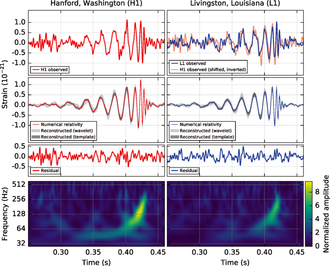
Back علم فلك الموجات الثقالية Arabic Observació d'ones gravitacionals Catalan Gravitační astronomie Czech Gravitationswellenastronomie German Astronomía de onda gravitacional Spanish اخترشناسی موج گرانشی FA Astronomie gravitationnelle French אסטרונומיית גלי כבידה HE Astronomia delle onde gravitazionali Italian 重力波天文学 Japanese

Gravitational-wave astronomy is a subfield of astronomy concerned with the detection and study of gravitational waves emitted by astrophysical sources.[1]
Gravitational waves are minute distortions or ripples in spacetime caused by the acceleration of massive objects. They are produced by cataclysmic events such as the merger of binary black holes, the coalescence of binary neutron stars, supernova explosions and processes including those of the early universe shortly after the Big Bang. Studying them offers a new way to observe the universe, providing valuable insights into the behavior of matter under extreme conditions. Similar to electromagnetic radiation (such as light wave, radio wave, infrared radiation and X-rays) which involves transport of energy via propagation of electromagnetic field fluctuations, gravitational radiation involves fluctuations of the relatively weaker gravitational field. The existence of gravitational waves was first suggested by Oliver Heaviside in 1893 and then later conjectured by Henri Poincaré in 1905 as the gravitational equivalent of electromagnetic waves before they were predicted by Albert Einstein in 1916 as a corollary to his theory of general relativity.
In 1978, Russell Alan Hulse and Joseph Hooton Taylor Jr. provided the first experimental evidence for the existence of gravitational waves by observing two neutron stars orbiting each other and won the 1993 Nobel Prize in physics for their work. In 2015, nearly a century after Einstein's forecast, the first direct observation of gravitational waves as a signal from the merger of two black holes confirmed the existence of these elusive phenomena and opened a new era in astronomy. Subsequent detections have included binary black hole mergers, neutron star collisions, and other violent cosmic events. Gravitational waves are now detected using laser interferometry, which measures tiny changes in the length of two perpendicular arms caused by passing waves. Observatories like LIGO (Laser Interferometer Gravitational-wave Observatory), Virgo and KAGRA (Kamioka Gravitational Wave Detector) use this technology to capture the faint signals from distant cosmic events. LIGO co-founders Barry C. Barish, Kip S. Thorne, and Rainer Weiss were awarded the 2017 Nobel Prize in Physics for their ground-breaking contributions in gravitational wave astronomy.
When distant astronomical objects are observed using electromagnetic waves, different phenomena like scattering, absorption, reflection, refraction, etc. causes information loss. There remains various regions in space only partially penetrable by photons, such as the insides of nebulae, the dense dust clouds at the galactic core, the regions near black holes, etc. Gravitational astronomy have the potential to be used parallelly with electromagnetic astronomy to study the universe at a better resolution. In an approach known as multi-messenger astronomy, gravitational wave data is combined with data from other wavelengths to get a more complete picture of astrophysical phenomena. Gravitational wave astronomy helps understand the early universe, test theories of gravity, and reveal the distribution of dark matter and dark energy. Particularly, it can help find the Hubble constant, which tells about the rate of accelerated expansion of the universe. All of these open doors to a physics beyond the Standard Model (BSM).
Challenges that remain in the field include noise interference, the lack of ultra-sensitive instruments, and the detection of low-frequency waves. Ground-based detectors face problems with seismic vibrations produced by environmental disturbances and the limitation of the arm length of detectors due to the curvature of the Earth’s surface. In the future, the field of gravitational wave astronomy will try develop upgraded detectors and next-generation observatories, along with possible space-based detectors such as LISA (Laser Interferometer Space Antenna). LISA will be able to listen to distant sources like compact supermassive black holes in the galactic core and primordial black holes, as well as low-frequency sensitive signals sources such as binary white dwarf merger and sources from the early universe.[2]
- ^ Patrick R. Brady; Jolien D.E. Creighton (2003), "Gravitational Wave Astronomy", Encyclopedia of Physical Science and Technology (3rd ed.), Academic Press, pp. 33–48
- ^ Rabinarayan Swain; Priyasmita Panda; Hena Priti Lima; Bijayalaxmi Kuanar; Biswajit Dalai (January–February 2022), "Gravitational waves: A review on the future astronomy", International Journal of Multidisciplinary Research and Growth Evaluation, 3 (1): 38–50